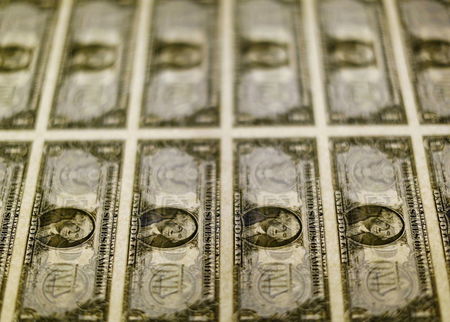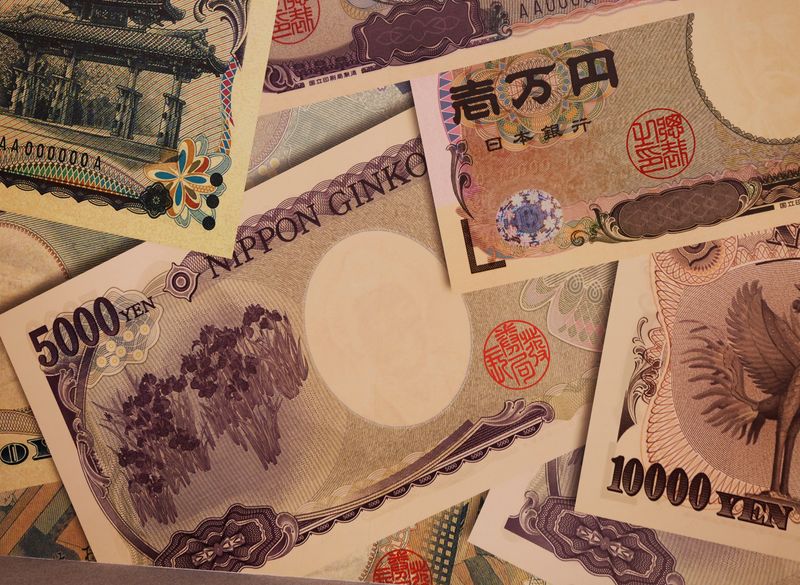Forex
US Stocks Tick Higher, Dollar Falls To 1-Month Low Ahead Of Fed News: What’s Driving Markets Today

The U.S. stock market ticked higher Wednesday ahead of the Federal Reserve’s afternoon interest rate announcement. The FOMC is largely expected to defer tightening interest rates at this meeting, snapping a streak of 15 consecutive hikes.Both the S&P 500 index and the tech-heavy Nasdaq 100 are on track to post their fifth straight session of gains. Wednesday also witnessed a lower-than-expected producer price inflation (PPI) print. The inflation measure fell from 2.3% in April to 1.1% in May, the lowest level since January 2020. Now, all eyes are on the FOMC policy statement, due at 2 p.m. ET, and Jerome Powell’s press conference at 2:30 p.m. The Fed will also unveil its revised economic projections, which will give the board’s assessment over interest rates, growth and inflation going forward. Cues From Wednesday’s Trading:The S&P 500 index moved 0.2% higher, while the Nasdaq 100 rose 0.4%, hitting levels last seen in early April 2022. Blue chip stocks in the Dow Jones Industrial Average eased 0.4% and the small-cap-heavy Russell 2000 fell 0.3%. US Index Performance Wednesday
Index
Performance (+/-)
Value
Nasdaq 100
+0.38%
14,986.11
S&P 500 Index
+0.24%
4,379.12
Dow Industrials
-0.33%
34,097.15
Analyst Color:”The resilience in the economy has been surprising – especially given the headwinds of 500 bps in tightening,” said Chris Zaccarelli, chief investment officer at Independent Advisor Alliance.The analyst attributes the stock market’s strength to the economy’s resilience.”Eventually higher rates will take their toll on the economy and markets, but in the meantime, both are likely to persist for longer than almost anyone would have expected as recently as six months ago,” he added.Wednesday’s Trading In Major US Equity ETFs: In midday trading on Thursday, the SPDR S&P 500 ETF Trust SPY was 0.3% higher to $438.08, the SPDR Dow Jones Industrial Average ETF DIA fell 0.3% to $341.55 and the Invesco QQQ Trust QQQ was 0.6% higher to $365.30, according to Benzinga Pro data.Almost all U.S. equity sectors were positive, except for the Energy Select Sector SPDR Fund XLE and the Health Care Select Sector SPDR Fund XLV. The Technology Select Sector SPDR Fund XLK slightly outperformed, up 0.9%, followed by the Utilities Select Sector SPDR Fund XLU, up 0.8%.Latest Economic Data:The Labor Department released its producer price index report, reporting a monthly decline of 0.3% in May compared to a 0.2% increase in April. In annual terms, headline PPI fell from 2.3% to 1.1%. Core producer prices may edged up 0.2%, the same pace of increase as in the previous month. On a year-over-year basis, core producer prices came in at 2.8%, slightly lower than the expected 2.9%.Stocks In Focus:
Coherent Corp. COHR rose 20% on Wednesday as the optoelectronics company announced a new product that it says will serve electric vehicle applications.
IPG Photonics Corp. IPGP rose 15% after Raymond James upgraded the company’s stock from Market Perform to Outperform, raising the price target to $170.
Humana Inc.’s HUM stock fell 14%, swept up in the downdraft generated by UnitedHealth Group Inc.’s UNH statement that its elderly clients are catching up on hip and knee procedures delayed by the COVID pandemic, raising insurance costs.
MicroVision, Inc. MVIS fell 28% as the company said Tuesday it plans a $75-million public offering of its common shares.
Homebuilder Lennar Corp. LEN is scheduled to release its quarterly results after the market close.
Commodities, Bonds, Other Global Equity Markets:Crude oil held steady, with a barrel of WTI grade crude trading at $69.43. The United States Oil Fund ETF USO was 0.1% higher to $62.23 per share. Treasury yields slightly fell, with the 10-year yield down by 3 basis points to 3.79% and the two-year yield down by 4 basis points to 4.63%. The iShares 20+ Year Treasury Bond ETF TLT was 0.6% higher for the day. The dollar fell, with the U.S. dollar index, which is tracked by the Invesco DB USD Index Bullish Fund ETF UUP, down 0.6%. The EUR/USD pair, which is tracked by the Invesco CurrecyShares Euro Currency Trust FXE, was 0.7% higher to 1.0860.European equities traded higher across the board. The SPDR DJ Euro STOXX 50 Etf FEZ rose 1.1%. Gold surged 0.6% to $1,955/oz. The SPDR Gold Trust GLD was 0.6% higher to $182. Silver rose 1.8% to $24, with the iShares Silver Trust SLV up 1.6% to $22. Bitcoin BTC/USD was flat at $25,927.Staff writer Piero Cingari updated this report midday Wednesday. Photo via Shutterstock.
Forex
Dollar steadies, but on track for sharp weekly loss

Investing.com – The U.S. dollar edged higher in European trade Friday, but was on track for a hefty weekly fall after cooling inflation and weak retail sales brought Federal Reserve rate cuts back into focus.
At 04:10 ET (08:10 GMT), the Dollar Index, which tracks the greenback against a basket of six other currencies, traded 0.2% higher at 104.580, marginally above a five-week low just below 104 seen earlier this week.
Dollar steadies after hawkish Fed speak
The dollar has recovered to a degree as several Fed officials, specifically members of the bank’s rate-setting committee, said that they needed much more confidence that inflation was coming down, beyond some easing inflation in April.
“I now believe that it will take longer to reach our 2% goal than I previously thought,” St. Louis Federal Reserve president Loretta Mester said on Thursday, adding that further monitoring of incoming data will be needed.
Federal Reserve Bank of New York President John Williams agreed with this view.
“I don’t see any indicators now telling me … there’s a reason to change the stance of monetary policy now, and I don’t expect that, I don’t expect to get that greater confidence that we need to see on inflation progress towards a 2% goal in the very near term,” Williams said.
However, the dollar is still on course for a weekly loss of around 0.7% after the milder than expected U.S. data raised expectations the will deliver two interest rate cuts this year, probably starting in September.
remove ads
.
U.S. were also flat in April and softer-than-expected, and manufacturing output unexpectedly fell.
“Our view for the near term remains that we could see a further stabilisation in USD crosses as markets await the next key data input: April core PCE on 31 May,” said analysts at ING, in a note.
Euro slips ahead of CPI release
In Europe, traded 0.1% lower to 1.0860, having traded as high as 1.0895 in the wake of U.S. inflation release, but the single currency is still up around 0.9% on the dollar this week.
The final reading of the is due later in the session, and is expected to show inflation rose by 2.4% on an annual basis in April.
The is widely expected to cut interest rates in June, but traders remain unsure of how many more cuts, if any, the central bank will agree to over the course of the rest of the year.
Traders have priced in 70 basis points of ECB cuts this year – a lot more than the just under 50 bps of easing priced in for the Fed.
fell 0.1% to 1.2658, but is still on track for gains of around 1% this week.
The Bank of England is also expected to cut rates from a 16-year high this summer, but volatility is likely to be limited ahead of the release of key U.K. inflation figures next week.
Yen slips after weak Japanese GDP data
In Asia, rose 0.3% to 155.87, close to breaking above 156, after weaker-than-expected Japanese data for the first quarter.
remove ads
.
traded 0.1% higher at 7.2209, moving back to six-month highs above 7.22 after data earlier Friday showed grew more than expected in April, but growth in slowed sharply, while a decline in Chinese house prices accelerated last month.
Forex
Hedge funds play a weak Japanese yen

By Nell Mackenzie
LONDON (Reuters) – Pressure on Japan to prop up a weak yen may have ebbed, but currency weakness remains a headache for Tokyo.
The yen is down 9.4% against the dollar so far this year, and looks set for a fourth year of declines. That’s created a two-speed economy, with exports and tourism benefiting from a more competitive exchange rate while households and small businesses are squeezed by rising import prices.
Four investment managers shared four ideas on how to trade yen weakness. Their views do not represent recommendations or trading positions, which they cannot reveal for regulatory reasons.
1/ FLORIN COURT CAPITAL
* Diversified systematic asset manager
* Size: $2 billion assets under management (AUM)
* Founded in 2016
* Key trade: Short-Asia currencies ex-Japan
Florin Court CIO Doug Greenig says that instead of playing a weak yen, investors should put on bets against Asia’s emerging market currencies.
“Investors can consider shorting other Asian currencies like the Korean Won or the Thai Baht, where real interest rates are also relatively low versus some other EM currencies,” Court said. “And you don’t directly face the risk of BOJ intervention.”
The Bank of Japan (BOJ) was believed to have intervened twice, on April 29 and May 1, to stabilise a yen that had slumped to 34-year lows around 160 per dollar. It is now around 155.6.
The yen has weakened sharply for clear reasons: real interest rates are much higher outside of Japan.
U.S. rates have been kept high by loose fiscal policy and a robust economy. By contrast, Japan does not have a free hand in raising policy rates, Greenig said.
remove ads
.
Japan’s huge public debt pile is 263% of GDP, but the Bank of Japan holds almost half of that, so the situation might be more nuanced than it looks, he said.
2/ AQR CAPITAL MANAGEMENT
* Systematic asset manager
* Size: $108 billion
* Founded in 1998
* Long Japanese stocks
Jonathan Fader, managing director in the Macro Strategies Group at AQR Capital Management, says BOJ intervention complicates matters for yen bears but the key driver of yen weakness remains – accommodative Japanese monetary policy while rates elsewhere are at multi-year highs.
He favours Japanese stocks that benefit from currency weakness.
Fader noted that the tight relationship between the yen and Japanese shares broke down as Tokyo stepped up verbal intervention. But stock tailwinds remained, such as governance improvements and banks benefiting from an end to negative rates.
The BOJ in March delivered its first rate hike in 17 years.
“Should yen volatility calm down, Japanese shares could well resume their outperformance,” said Fader.
Japan’s blue-chip is off record highs hit earlier this year, but is still up some 16% year-to-date.
3/ MOUNT LUCAS MANAGEMENT
* Macroeconomic hedge fund
* Size: $1.5 billion
* Founded in 1986
* Dollar/yen forwards
For David Aspell, partner at Mount Lucas, a large U.S/Japan rate gap means investors will continue to use the yen as a funding currency for carry trades.
One way to play yen weakness is through currency forwards, contracts that allow investors to hedge FX risk, he said.
remove ads
.
Buying a dollar/yen one-year forward contract which trades at a discount to current levels means the currency pair would need to weaken over a year to loose money, said Aspell. Investors would gain if there is no change or dollar/yen strengthens.
“Intervention has the best chance of working medium term when it is a genuine surprise and when it is helped along by the fundamentals,” Aspell said.
4/ PINEBRIDGE INVESTMENTS
* Global asset manager
* Size: $168.2 billion
* Independent since 2010
* Buy high quality, investment grade portions in short duration, refinanced U.S. 2024 CLOs
The BOJ has also abandoned yield curve control where it capped long-term interest rates around zero, but said it would keep broadly buying government bonds as before and ramp up purchases if yields rise rapidly.
Since this policy’s 2016 start, Japanese investors sought higher returning investments elsewhere. The plus 5% yields on investment grade tranches (portions) of U.S. collateralized loan obligations (CLOs) drew many.
“Right now as investors in CLOs, they are our competition because they have such a strong demand for U.S. fixed income assets,” Laila Kollmorgen, a PineBridge managing director, adding that what Japanese investors do will determine how Pinebridge invests later in the year.
Now that JGB yields have hit decade highs, this might tempt Japanese investors to bring funds back home.
“We must remain nimble,” Kollmorgen says.
While the typical CLO deal length is eight years, she’d opt for newly reset CLOs in 2024. On these, the deal time has been restarted. She’ll look for an extended three-year reinvestment period, refinanced debt and lender protection against the bonds being paid back in full during the first year.
remove ads
.
Forex
Dollar selling “looks exaggerated” – HSBC

Investing.com – The U.S. dollar is on track for a hefty weekly fall on renewed dovish hopes for the Federal Reserve, but this selling “looks exaggerated”, according to HSBC.
At 05:25 ET (09:25 GMT), the Dollar Index, which tracks the greenback against a basket of six other currencies, traded at 104.640, on course for a weekly loss of around 0.5%, as well as a monthly drop of 1.3%.
The USD has suffered from a “double whammy” lately, according to analysts at HSBC, in a note dated May 16.
Softer-than-expected U.S. activity data and the lack of further upside surprises in April inflation data have rejuvenated dovish hopes for the Fed–hitting the USD through the rates channel–and helped spur risk appetite–hurting the USD through the risk appetite channel which has shown recent signs of gaining more traction.
However, this two-pronged hit to the USD can also play in the opposite direction, the bank added.
After three months of upside surprises, the Fed may need more than one month’s in line inflation data to be confident about inflation moving to target.
Also, Fed rhetoric arguing for patience might unsettle the market ahead of the June FOMC where new “dots” lie in wait.
“We look for the USD selling of the last month to stop in the coming weeks, with a bounce possible against those currencies that could deliver a dovish surprise, or which are vulnerable to risk aversion,” the U.K.-based bank said.
HSBC has chosen to express this expected shift in dollar tone against the euro – opening a trade idea to sell at $1.0880, targeting $1.0550, with a stop at $1.1050.
remove ads
.
At 05:25 ET, EUR/USD traded at $1.0841, on course for a weekly gain of 0.7% and a monthly increase of 1.9%.
“While ECB rhetoric suggests a June rate cut seems all but certain, we believe the market may be under-pricing the risk that the door will be left open to a follow-up cut in July,” the bank said.

 Forex2 years ago
Forex2 years agoForex Today: the dollar is gaining strength amid gloomy sentiment at the start of the Fed’s week

 Forex2 years ago
Forex2 years agoHow is the Australian dollar doing today?

 Forex1 year ago
Forex1 year agoUnbiased review of Pocket Option broker

 Forex2 years ago
Forex2 years agoDollar to pound sterling exchange rate today: Pound plummeted to its lowest since 1985

 Cryptocurrency2 years ago
Cryptocurrency2 years agoWhat happened in the crypto market – current events today

 World2 years ago
World2 years agoWhy are modern video games an art form?

 Stock Markets2 years ago
Stock Markets2 years agoMorgan Stanley: bear market rally to continue

 Economy2 years ago
Economy2 years agoCrude oil tankers double in price due to EU anti-Russian sanctions

































